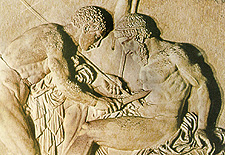
Finds of instruments throughout the Roman Empire indicate that the art of
surgery had progressed and proliferated. If any one of the branches of medicine
had achieved true competence in the Empire, surgery is the most serviceable
example. Surgery was important in the training of the conscientious physician,
and both Galen and Celsus emphasize it although they came from divergent medical
traditions (Celsus, prooemium VII; Galen, II, 272).
Technical competence in surgery became better as new shapes were devised for
medical tools, and as new metals and alloys were found to provide sharper edges
and cheaper equipment. Most instruments were made of bronze, or occasionally of
silver. Iron was rarely used because, as in most ancient cultures, it was
considered taboo by both the Greeks and Romans, and so was never used for
surgical instruments on religious grounds. The design of many medical
instruments remained unchanged and the quality of manufacture was seldom
bettered until recent times. The full repertoire for Roman surgical equipment is
far from completely known, and newly identified tools include a special forceps
for applying caustics.
Bas Relief Fragment, 4th Century CE, Athens, National
Museum
This fragment shows a doctor performing an operation on a patient's
head while Asclepius (identifiable by his superhuman size and the caduceus
in his right hand) looks on. |
Occasionally instruments not originally manufactured for surgical
purposes were implemented. Galen and Celsus both mention that the strigil,
a curved piece of metal with a handle used for scraping oil and sweat off
the body after exercise, was often used to get into small openings. Galen
says, ďAfter having heated the fat of a squirrel in a strigil, insert it
into the auditory canalĒ (Galen, XII, 623).
Surgery was refined as long as the patient had courage and the doctor
had good tools and experience. The patientís chances increased if the head
and abdomen were not involved. A cursory reading of Celsusí summary of
surgical techniques as they existed in the first century shows a sure
knowledge of human anatomy.
|
| Archaeological remains of what appear to be surgeonís shops are common
enough to indicate physicians specialized in surgery. Particularly famous
is the so-called House of the Surgeon at Pompeii, where most of the
surgical tools now housed in Naples were found. Philological evidence
seems to support the idea that there was at least some distinction, even
if not a rigid one, between general practitioner and surgeon. Medieval
texts distinguish the two positions with different terms: medicus for a
doctor, and magister for a surgeon.
|
Stele from Herculaneum, 1st Century BCE
Surgeon excising an arrow from a wounded soldier Both men are
depicted nude, suggesting that the episode stems from a mythic
tale. |
The Romans enlarged upon the variety of
instruments available for surgery, and Galen wrote detailed instructions on
their use. The makers of medical instruments are at best shadowy figures. The
well-known relief pictured below is one of the few archaeological finds which
helps clarify the situation. It suggests that some medical instruments were
manufactured by specialist blade makers rather than by craftsmen who specialized
in medical instruments. It seems improbable that there would have been
sufficient demand for craftsmen dealing exclusively in medical instruments and
there is as yet no known inscription naming such a specialist. In the larger
cities of the Roman empire, physicians would probably have found craftsmen who
could provide the broad range of medical equipment.

Case
Studies 


